Dealing with Japanese Knotweed has long been a widely known issue, although many struggle to identify it accurately. This invasive plant grows so rapidly that it can damage infrastructure like pavements, roads, and buildings. Removing it is challenging, often requiring professional assistance.
Now, let’s address the essential question:
What are the legal obligations concerning Japanese Knotweed?
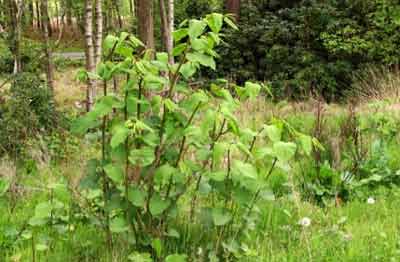
Japanese Knotweed Growing Wild – Image courtsey of RHS
Current Laws Regarding Japanese Knotweed
Japanese Knotweed is an invasive species, and landowners have a duty to prevent its spread and actively eradicate it – DEFRA provide more information about Invasive Species here. The plant and any soil it grows in are classified as controlled waste, requiring specific disposal methods, similar to asbestos. It’s not recommended to burn it yourself.
While it’s not illegal to have Japanese Knotweed on your land, planting or cultivating it is a criminal offence under the Wildlife and Countryside Act 1981. Failure to take reasonable steps to prevent its spread or prove innocence can result in penalties.
Although not a notifiable weed, ignoring Japanese Knotweed is unwise as it can spread rapidly. When selling property, its presence must be disclosed on the TA6 form. Failure to do so could lead to legal consequences.
If Japanese Knotweed encroaches on a neighbour’s property due to negligence, it may be considered a private nuisance under common law, potentially resulting in legal action and property damage claims.
Recent Legislation Impacting Japanese Knotweed
A recent court ruling allows individuals to sue for damages caused by uncontrolled Japanese Knotweed. This ruling reflects ongoing changes in the law related to this invasive plant.
Since 2014, an amendment to the Anti-social Behaviour, Crime and Policing Act 2014 addressed Japanese Knotweed and other invasive plants. Here are the key points:
- Having Japanese Knotweed on your property is not illegal.
- You’re still responsible for controlling Japanese Knotweed. If its presence significantly affects the quality of life in the area, authorities can enforce its control at your expense.
- You can manage the plants yourself, but you must follow guidelines for control and disposal.
Eradicating Japanese Knotweed is challenging and may take up to 5 years with herbicides. Neighbours affected by the weed need to be given time to address the issue.
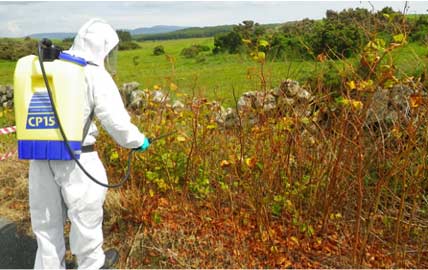
Spraying Japanese Knotweed with Herbicides – Image courtesy of Galloway Fisheries Trust
In a significant 2018 ruling, the Court of Appeal awarded £30,000 in compensation for damages caused by Knotweed spreading from a neighbouring property.
This case, against Network Rail, sets a precedent for legal action against negligent property owners failing to control Japanese Knotweed, which can encroach on neighbouring properties.
Can You Handle Japanese Knotweed Yourself?
Yes, you can treat Japanese Knotweed yourself, but it’s not always straightforward.
Consider hiring a professional firm for several reasons. They can provide necessary documentation, especially if there’s a risk to neighbours or if you plan to sell or borrow against your property.
Professional firms offer ongoing insurance-backed guarantees, ensuring the problem won’t return. They also have access to stronger chemicals, enabling quicker eradication, which is crucial if you’re in a hurry to sell.
Given that eliminating Japanese Knotweed can take 3-5+ years, reducing this timeframe is significant. Find a suitable professional in your area here.
Dealing with Japanese Knotweed: Control, Kill, or Remove It
Options for managing Japanese Knotweed are limited. While you’re not obligated to control it on your property, neglecting it can lead to legal issues if it encroaches on others’ land.
Act promptly to prevent its spread. Early intervention is key to avoiding escalation.
Typically, chemical weed killers are used to eradicate it, as removing it entirely has drawbacks. More on this below.
The Environment Agency provides clear guidelines on preventing knotweed spread, available here.
Controlling Japanese Knotweed
Japanese Knotweed requires management due to its growth and spreading nature.
It’s recommended to post signs and control access to the area to prevent unintentional spread.
On development sites, fencing with a 7-meter barrier is advised, limiting access to trained personnel only.
All vehicles leaving the area should undergo pressure washing and you should avoid the use of tracked vehicles.
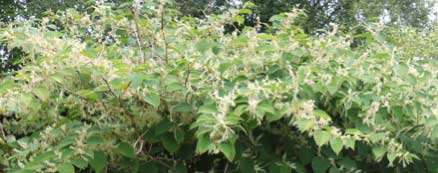
Japanese Knotweed in Flower – Image courtesy of environetuk.com
Avoid cutting or strimming Japanese Knotweed. If cutting is necessary, dispose of all plant parts according to these guidelines.
Composting is not advisable as it can propagate the plant further.
Cutting weakens but doesn’t kill it; rhizomes continue to grow underground.
Burning requires special exemptions for businesses; private burning should be verified with local regulations.
However, burning often fails to eradicate it, leading to regrowth.
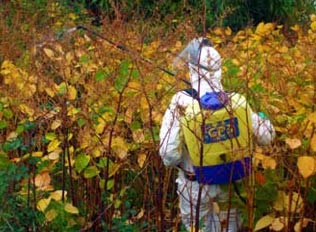
Spraying Japanese Knotweed it generally the most effective control – Image courtesy of Control Japanese Knotweed
Transporting and Disposing of Japanese Knotweed
Digging up and moving knotweed poses a high risk of spreading it, as it can regrow from any part of the plant.
A registered waste carrier is required to transport knotweed waste, ensuring it’s securely enclosed to prevent escape.
The soil accompanying the plant is also considered contaminated waste and must be disposed of accordingly.
Verify that the disposal site is licensed to handle knotweed and ready to receive it separately from other waste.
Burying Japanese Knotweed
Burying Japanese Knotweed is often ineffective due to its resilience. It’s known to survive extreme conditions, even under layers of rock and volcanic ash.
If you choose to bury it, ensure the site is authorised for knotweed disposal. If relocating, follow the guidelines mentioned earlier.
When burying on-site, use a weed membrane to prevent regrowth and bury it under at least 5 meters (16 feet) of soil. Alternatively, fully encase the plant and soil in the membrane and bury it 2 meters (6.5 feet) deep if deeper burial is not feasible.
Do not mix it with other waste.
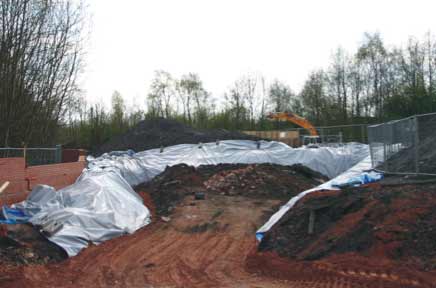
Burying Japnese Knotweed is a significant undertaking – Image courtesy of Dendro-Scott Root Barrier
Burning Japanese Knotweed
Businesses burning knotweed must obtain permits and notify local councils and the Environment Agency. Private individuals should check with their council for permission.
Burning can be problematic as some parts, like the rhizome, can survive and regrow. Ensuring the plant is thoroughly dried before burning improves effectiveness.
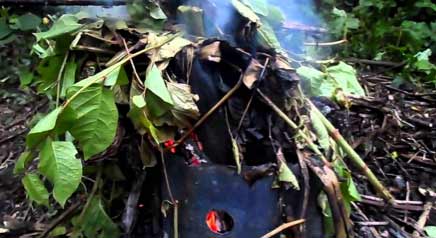
Burning Japanese Knotweed can be problematic – Image Friends of Speckled Wood
Chemical Controls for Japanese Knotweed
Spraying with herbicides is effective but slow, typically taking 3-5 years to kill the plant. Follow safety guidelines provided with the chemical, and seek permissions if spraying near protected sites or water bodies.
Herbicides can be dangerous, so always ensure you follow any and all safety instructions, both supplied by the manufacturer and also those on the HSE website here.
When it comes to spraying there are specific rules to follow, these need to be following by any companies licensed to spray knot weed or if you are spraying yourself and are located in a protected area such as an Area of Special Scientific Interest. Find out more on the Natural England website.
If you are located near water and are spraying, then you will need to obtain permission from the Environment Agency – you can get more information here.
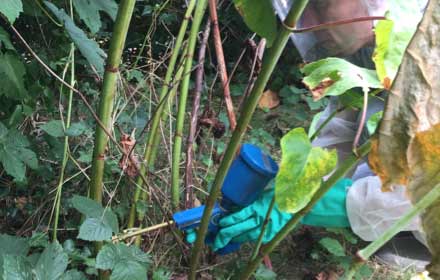
Using Chemicals to Control Japanese Knotweed – Image Greencut Horticulture
Use potent Glyphosate weed killer. Spray plants until they dry back, then treat re-growth. Research suggests (this study by Professor Dan Eastwood and Dr Dan Jones of Swansea University) a 4-stage treatment process can expedite eradication, targeting vulnerable points in the plant’s life cycle.

Consistent spraying until regrowth stops is crucial for successful eradication.
Japanese Knotweed and Mortgages
Japanese Knotweed near your home can hinder mortgage approval.
Lenders typically require a management plan or insurance-backed guarantee for treatment.
In severe cases, they may withhold lending until the issue is resolved.
A survey can confirm the presence of Knotweed and guide treatment options.
Proximity to the house matters most; action is necessary if within 7m (23 ft).
For non-habitable buildings, leniency may apply.
Remember: It’s the proximity, not ownership, that’s crucial.
Mortgage providers often require upfront payment for a solution.
Buyers should negotiate this with sellers.
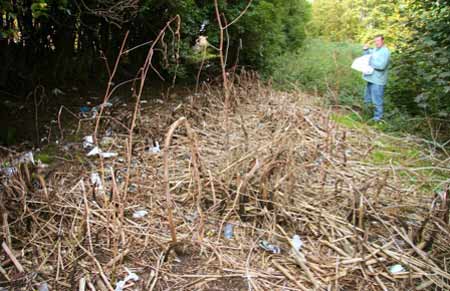
Repeated treatment of Japanese Knotweed will eradicate it – Image: Japanese Knotweed Survery
Impact of Japanese Knotweed
Japanese Knotweed is infamous for its destructive potential, with myths of it damaging buildings within a 7m radius. It’s resilient, thriving almost anywhere and difficult to eradicate. Introduced to Europe in 1850, it was once popular among Victorian gardeners until its invasive nature became evident in the late 19th century. By the 1990s, it was removed from nurseries due to its invasive traits. Mortgage lenders began imposing control criteria in the 2000s.
Originating from Japanese volcanic slopes, it adapts to harsh conditions, even growing through rock and ash. Its rhizome, akin to a tuber, stores nutrients for survival during dormancy. Remarkably, even cut rhizome parts can sprout into new plants. While it dominates and crowds out other species, recent studies challenge its infamous reputation.
A University of Leeds and Aecom study suggests Japanese Knotweed’s root system rarely extends beyond 13ft, contrary to the alleged 23ft, and it may not be as damaging as believed. Despite this, lenders are unlikely to change their cautious stance until further research confirms these findings.
Although Japanese Knotweed may not be as destructive as feared, legal regulations remain stringent, necessitating its control if found on your property.
Although Japanese Knotweed is now know not to be as damaging and problematic as first thought, it is still a problem and one that can have serious consequences for mortgages and the likes, so it should never be ignored and should certainly be dealt with as soon as possible.

